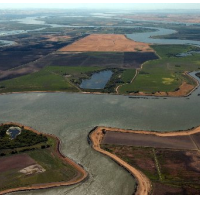SoCal Water District Goes Island Shopping in the Delta
 Webb Tract, top, and Bouldin Island, lower right (photo: Bay Area News Group)
Webb Tract, top, and Bouldin Island, lower right (photo: Bay Area News Group)
Officials of the Metropolitan Water District of Southern California (MWD) have come to the Sacramento-San Joaquin Delta as friends, bearing gifts, which they wish to bestow upon the environment if they would be allowed to purchase five islands for up to $240 million.
There are skeptics. “Can you say the words ‘Owens Valley’ and ‘Chinatown’?” Friends of the River policy director Ron Stork asked the Sacramento Bee. “It certainly has that odor.”
The largest water district in the state has been talking for months to the Delta Wetlands Project, a public-private partnership that owns the property. The private part of that partnership is a subsidiary of Zurich Financial Services Ltd. in Switzerland.
The project’s two-decade aim has been to “store water on two low-lying islands in the Sacramento-San Joaquin Delta during high winter run-off periods and return the water back to the Delta channels during the summer as a new source of water for the region.”
The 20,000-acre purchase includes Bouldin Island, Bacon Island, Webb Tract, most of Holland Island and part of Chipps Island. In pursuit of “co-equal goals of improving water supply reliability and ecosystem restoration,” 9,000 acres on two islands would be transformed into protected wetlands and wildlife habitat.
MWD says it will continue that fine environmental work because without a healthy Delta, the source of water for 23 million Californians and millions of acres of farmland won’t be worth much. But the district has no intention of pursuing the project’s goal of building reservoirs that could store 70 billion gallons of water during wet years.
MWD General Manager Jeff Kightlinger said the islands could facilitate building the $15.3-billion twin tunnels under the Delta that Governor Brown wants by reducing eminent-domain needs and providing a storage place for construction dirt.
The Los Angeles Times said the islands also come with water rights, “some of which could potentially be used to boost southbound deliveries—or increase Delta outflow to meet environmental standards.”
It’s those southbound deliveries that have environmentalists and others concerned about the health of the Delta. Last April, the governor gave up on his $24.5-billion effort to both build the tunnels and rebuild the Delta’s infrastructure, and ditched the environmental stuff for later.
By severing much of the environmental work, the administration can apply for permits of 10 years or less rather than 50-year permits that have more stringent requirements. That longer permit process looked dicey last September when the U.S. Environmental Protection Agency (EPA) trashed a draft version of the Delta plan.
The Delta, 60 islands among 700 square miles, has been sculpted and resculpted by humans since the first settlers arrived in the area. It lies at the confluence of the Sacramento and San Joaquin rivers.
The islands are surrounded by channels and sloughs, and are home to 750 distinct species of plants and wildlife. An 1,100-mile maze of levies, many in disrepair, protects farmland and infrastructure from flooding and intrusions of saltwater.
The MWD board authorized Kightlinger last week to negotiate options on the islands. Although MWD has a huge stake in importing water from the north, the purchase wwas said to be the first time it held a direct stake in Delta property.
–Ken Broder
To Learn More:
Southern California Deal for Delta Islands Could Cost Up to $240 Million (by Dale Kasler and Ryan Sabalow, Sacramento Bee)
MWD Considers Buying 4 Delta Islands to Solve Some Water Problems (by Bettina Boxall, Los Angeles Times)
Los Angeles Water Agency Trying to Purchase Delta Islands (by Matthias Gafni, Bay Area News Group)
California's Water: Sacramento-San Joaquin River Delta (Association of California Water Agencies)
Delta Water Plan Simplified by Focusing on Tunnels and Bagging the Restoration (by Ken Broder, AllGov California)
- Top Stories
- Controversies
- Where is the Money Going?
- California and the Nation
- Appointments and Resignations
- Unusual News
- Latest News
- California Forbids U.S. Immigration Agents from Pretending to be Police
- California Lawmakers Urged to Strip “Self-Dealing” Tax Board of Its Duties
- Big Oil’s Grip on California
- Santa Cruz Police See Homeland Security Betrayal in Use of Gang Roundup as Cover for Immigration Raid
- Oil Companies Face Deadline to Stop Polluting California Groundwater





